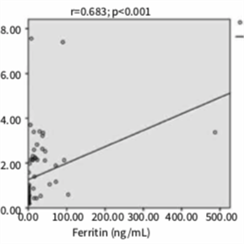Objective: Differential diagnosis of iron deficiency anemia (IDA) and anemia of chronic disease (ACD) is performed based on some biochemical indicators of iron metabolism. Although these traditional indicators are useful to determine iron status, they may not provide conclusive criteria for determining iron deficiency because of their high variability and low sensitivity. The aim of the present study was to evaluate the clinical significance of neutrophil gelatinase-associated lipocalin (NGAL) in the differential diagnosis of IDA and ACD and to compare it with other conventional anemia parameters.
Materials and Methods: A total of 35 patients with IDA with serum hemoglobin<12 g/dL, transferrin saturation (TSAT)<20%, and serum ferritin<20 ng/mL and 31 patients with ACD with serum hemoglobin<12 g/dL, TSAT >20%, and serum ferritin >50 ng/mL were enrolled in the study.
Results: The median serum NGAL values were 0.44 (0.32-0.66) ng/mL in the IDA group and 2.16 (1.39-3.22) ng/mL in the ACD group, and a statistically significant difference was observed between the two groups with respect to NGAL (p<0.001). NGAL showed a significant positive correlation with hematocrit, mean corpuscular volume, mean corpuscular hemoglobin, mean corpuscular hemoglobin concentration, serum iron, TSAT, and ferritin (p<0.001) and a significant negative correlation with transferrin and total iron-binding capacity (p<0.001). The NGAL cut-off value was obtained as 1.02 ng/mL (97.1% sensitivity and 83.9% specificity) for the differentiation of IDA from ACD by receiver operating characteristic analysis.
Conclusion: Our data suggest that NGAL can be a useful parameter in the differential diagnosis of IDA and ACD. An NGAL cut-off value of 1.02 ng/mL predicts differential diagnosis.

.png)


.png)

.png)
